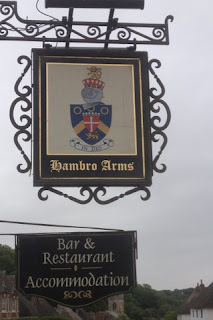Salisbury to Old Sarum
Who
Turned Up
Wendy, Sue, Trudy B, Trudy H, Beatrice
and Tony H, Diane and Tony R, Colin and David H. Once again we were pleased to be joined by Ray and Olga for lunch.
The
Walk
The weather forecast said warm and sunny,
but when could we ever trust weather forecasters? We had a spot of rain on the
cars as we drove north to Salisbury, but it stopped before we got to the Park
and Ride. We used our passes to ride into the town centre and then walked the
usual route through the shopping centre and out onto the riverside path. In the event, the
day turned out to be a good one for a walk as it was not too hot while we were
plodding our way up towards Old Sarum.
Old Sarum? What do we know about that?
Well, it’s the site of the oldest settlement in the Salisbury area. The name is
probably a corruption of the medieval and Latin forms of Salisbury. It appeared
in the Domesday Book as Sarisburie. It seems to have become Sarum around the
thirteenth century. The fourteenth century Bishop Wyvil described himself as
Episcopus Sarum. But you probably knew that already. And you probably knew that
New Sarum was the formal name of the present-day city of Salisbury right up
until 2009.
With the monoliths at Stonehenge and
Avebury not far away, there are indications of prehistoric settlements in this
area dating back to 3000BC. An iron age hill fort was erected at Old Sarum
around 400 BC, just a bit too soon for Wednesday walkers to have noticed it. The
Saxons took over the fort in the sixth century and used it as a stronghold
against marauding Vikings. Later, the Normans erected a motte and bailey castle
here which encompassed a great cathedral. Later still, a royal palace was built
for King Henry l. About three hundred years later, the cathedral was moved out
into the surrounding plain. New Sarum, or New Salisbury, grew up around the
site of that new cathedral and the buildings at Old Sarum were dismantled so
that the stones could be recycled. Edmund Blackadder (Churches recycled and bishops
unfrocked) Ltd is believed to have made a fortune out of selling the stones to
Baldrick Builders (Cunning plans a speciality) Ltd of New Sarum. After that,
the old settlement dwindled away until it became what it is today. However, it
retained parliamentary representation as a rotten borough and it served the
Pitt family.
Well, that’s enough of this week’s
history lesson. Let’s go back to the walk.
After lunch the day was still overcast,
but it was dry so we ambled our way back down across the fields of Stratford-sub-castle
and back into the town. The rain came on just as we boarded the bus back to the
Park and Ride.
Thanks this week are due to Diane and Tony
for the tea and cakes.
And thanks to Diane, Colin and both Trudys for the photographs.
And thanks to Diane, Colin and both Trudys for the photographs.
The
Pub
The Harvester at Old Sarum. Most of us
had a satisfactory meal but two of the chicken meals were not quite up to
scratch.
Next
Week
Meet at David's for a walk from Slap Bottom... honestly!































